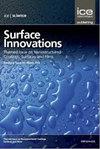Laminar drag reduction in closed channel using bioinspired textured surfaces
IF 3.5
4区 材料科学
Q3 CHEMISTRY, PHYSICAL
引用次数: 0
Abstract
Low flow drag is of great importance to a variety of engineering applications, and an effective way to achieve low drag is to use bioinspired micro-structured surfaces. This work aims to reduce the skin-friction drag in closed channel flow using textured surfaces inspired by leaves of indocalamus and rice. The channel formed by a polydimethylsiloxane chunk and a silicon wafer was fabricated to study drag reduction behavior for water or liquid paraffin oil in laminar flow. Bioinspired textures were processed on silicon wafer surface using deep silicon plasma etching method. We measured the pressure drop of water or paraffin oil passing through textured channels with different velocities. The maximum pressure drop reduction for the paraffin oil flow with low velocity (Re≈1) and for the water flow with high velocity (Re<1000) were about 5.1% and 27.3%, respectively. We also presented the contact angles of bioinspired textured surface, and then proposed mechanisms to explain the drag reduction. The hydrophobicity leading to the changing from the liquid-solid interface to the liquid-air interface is believed to provides the drag reduction for water flow, while the thin oil film formed on the textured surface due to the oleophilicity helps to reduce the oil flow drag.层流阻力减少在封闭通道使用生物启发纹理表面
低流动阻力在各种工程应用中都非常重要,而实现低阻力的一种有效方法是使用仿生微结构表面。这项工作旨在利用受吲哚和水稻叶片启发的纹理表面来减少闭合通道流中的皮肤摩擦阻力。制备了由聚二甲基硅氧烷块和硅片形成的通道,以研究水或液体石蜡油在层流中的减阻行为。采用深硅等离子体刻蚀方法在硅片表面处理仿生纹理。我们测量了水或石蜡油以不同速度通过纹理通道的压降。低速(Re≈1)石蜡油流和高速(Re<1000)水流的最大压降分别约为5.1%和27.3%。我们还介绍了仿生纹理表面的接触角,然后提出了减阻的机制。从液-固界面向液-气界面转变的疏水性被认为为水流提供了阻力降低,而由于亲油性而在纹理表面上形成的薄油膜有助于降低油流阻力。
本文章由计算机程序翻译,如有差异,请以英文原文为准。
求助全文
约1分钟内获得全文
求助全文
来源期刊

Surface Innovations
CHEMISTRY, PHYSICALMATERIALS SCIENCE, COAT-MATERIALS SCIENCE, COATINGS & FILMS
CiteScore
5.80
自引率
22.90%
发文量
66
期刊介绍:
The material innovations on surfaces, combined with understanding and manipulation of physics and chemistry of functional surfaces and coatings, have exploded in the past decade at an incredibly rapid pace.
Superhydrophobicity, superhydrophlicity, self-cleaning, self-healing, anti-fouling, anti-bacterial, etc., have become important fundamental topics of surface science research community driven by curiosity of physics, chemistry, and biology of interaction phenomenon at surfaces and their enormous potential in practical applications. Materials having controlled-functionality surfaces and coatings are important to the manufacturing of new products for environmental control, liquid manipulation, nanotechnological advances, biomedical engineering, pharmacy, biotechnology, and many others, and are part of the most promising technological innovations of the twenty-first century.
 求助内容:
求助内容: 应助结果提醒方式:
应助结果提醒方式:


